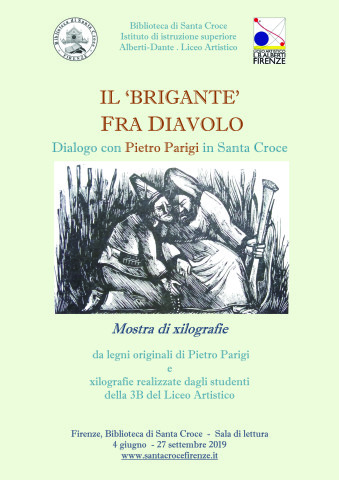 Mostra a tema di xilografie / Themed exhibition of woodcut prints
Mostra a tema di xilografie / Themed exhibition of woodcut prints
BIBLIOTECA DI SANTA CROCE FIRENZE – IIS ALBERTI DANTE
ATTIVITA’ DIDATTICA 2018/2019
Lontano dall’adesione passiva a correnti artistiche a lui contemporanee, quali il liberty o il futurismo, Pietro Parigi (1892-1990) elabora un linguaggio originale partendo dai grandi maestri della tradizione come Giotto, i giotteschi, Cimabue. Anche per questo, a Firenze, i Francescani della Basilica di Santa Croce istituivano un museo a lui dedicato, al termine di una lunga, e proficua, attività del Maestro come illustratore per non poche prestigiose case editrici e istituti culturali.
Fino a ottobre 2019 – da lunedì a venerdì – con la mostra «Il ‘brigante’ Fra Diavolo: dialogo con Pietro Parigi in Santa Croce», allestita nella Biblioteca di Santa Croce, sala di lettura, ambiente attrezzato a ospitarla (sono messi in mostra anche documenti e fotografie dell’epoca), è possibile approfondire la conoscenza di un ciclo di illustrazioni realizzate dal Maestro per il romanzo storico «Fra Diavolo» (Vallecchi, 1932).
Il «fallimento dell’istinto non sublimato dalla Grazia», così l’autore del romanzo, Piero Bargellini, vede il personaggio che lo spinge a mantenere nelle pagine un alto tono di pietà. Nasce così l’idea di far ‘dialogare’ ventidue nuove xilografie, realizzate dagli studenti dell’IIS Alberti-Dante di Firenze, per il romanzo, con quelle del maestro Parigi già tirate dai legni originali ed esposte per l’occasione.
La mostra espone anche alcune lettere autografe del Maestro Parigi, documenti e fotografie d’epoca che rimandano al romanzo, alle sue belle illustrazioni (realizzate, di proposito, con uno stile “scheggiato”), all’ambito culturale generato dall’elaborazione della figura del ‘brigante’ più famoso della storia.
Un vademecum consente di recarsi presso il sottostante ‘Museo Pietro Parigi’ (area “Chiostrino antico”) per scoprire quanto esposto sull’opera, come le matrici di legno incise dall’artista, utilizzate per illustrare il romanzo, gli strumenti di lavoro impiegati.
A great artist
(Library of Santa Croce in Florence / Monday – Friday)
Far from passive adherence to contemporary artistic currents, such as Liberty style (Art nouveau) or Futurism, Pietro Parigi (1892-1990), an engraving artist and book illustrator, elaborates an original ‘language’, starting from great masters of tradition like Giotto, Cimabue. The exhibition (woodcuts prints) concerns a novel illustrated by Pietro Parigi: it is an “historical novel” entitled «Fra Diavolo». The author is Piero Bargellini (Pier Francesco Bargellini), italian writer and politician, born in Florence in 1897 and here died in 1980. With his writings he made known Florentine art and culture in the world. He wanted to promote the relationship between faith and culture and he became famous with his first books works «Fra Diavolo» (1932) and «San Bernardino da Siena» (1933).
The novel “Fra Diavolo” tells the true story of an italian ‘brigand’ called ‘Fra Diavolo’ (when he was a child his mother had dressed him in a friar’s habit). Actually he was a patriot: he decided to defend king Ferdinand IV, of the house of Bourbon (Kingdom of Naples), from Napoleon, however he was hanged as a common criminal. Even his enemies admired him for his skill! For Bargellini these italian ‘brigands’ often were very religious, but they also were impulsive: even though they were generous, they had no Charity.
‘Fra’ Diavolo inspired the opéra-comique «Fra Diavolo, ou de L’Hôtellerie de Terracine» by Daniel Auber (1830), and «The Devil’s Brother», a comedy film with Laurel & Hardy (1933), directed by Hal Roach, and with Dennis King as Fra Diavolo.
Hung on the walls you can see Parigi’s woodcuts prints (about the novel), next to illustrations made by today’s students for the same book (artistic high school “Alberti-Dante” in Florence). Pietro Parigi and Piero Bargellini had work relationships, but they also were friends and some letters, and photos, prove it. In one letter Pietro Parigi explains to his friend Bargellini why he choose to represent a sad woman: actually he had seen her carrying her son’s coffin on her head, in Naples, in the early 20th century.
A vademecum allows you to go to “Pietro Parigi Museum”, inside Santa Croce, to see wood matrices engraved by the artist and used to illustrate the novel, artist’s work tools.
bibliotecasantacroce@gmail.com
Visita il Museo Pietro Parigi
Also visit the Permanent Pietro Parigi Exhibition

